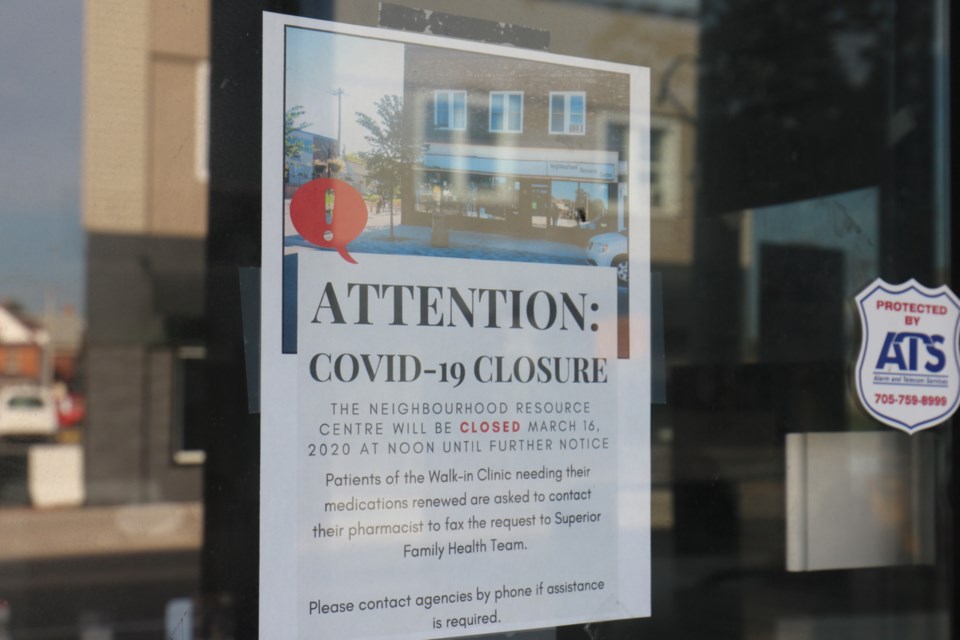The sign posted on the front door of the Neighbourhood Resource Centre says the place closed March 16 because of the COVID-19 pandemic.
"Until further notice," the sign reads.
The truth, however, was more complicated than that.
In fact, the much-ballyhooed drop-in centre has been secretly wrestling with a hot mess of other issues that made permanent closure of its current location at 138 Gore St. inevitable, this week's meeting of the Downtown Association was told by Sault Police Chief Hugh Stevenson.
The Algoma Leadership Table, with representatives from social and emergency services, health care institutions, school boards and post-secondary institutions, is now drafting a news release announcing the end of the NRC at the site it has occupied for the past six years.
But these local leaders are also hoping to start a new multi-agency NRC with tighter governance, at a new location.
At the Downtown Association's Wednesday-night meeting, Chief Stevenson said while 138 Gore must close: "It's not forever. It's a temporary issue."
The police chief painted a picture of “loosey-goosey” oversight, a building delcared unfit for human occupancy, and a landlord unwilling to fix it.
He also cited concerns that the NRC had turned into a magnet for problem activity as bad or worse than the issues it was designed to address.
The Neighbourhood Resource Centre was founded in 2014, spawned by Sault Ste. Marie Police Service’s community mobilization policing model.
That's a strategy that uses community engagement to deter and prevent crime.
Police had noticed a large number of calls for service within 1,000 metres of the Gore/Albert intersection, most involving social disorder issues including landlord-tenant disputes, domestic violence and child welfare.
NRC started with eight partner agencies, a number that eventually grew to more than 40.
The drop-in centre served as a community hub where people could go to access food, health and dental care and other services they may have had difficulty accessing through normal channels.
"I will tell you, as chief, that it started to turn into a bit of a hangout," Chief Stevenson told the Downtown Association.
"People would come in, get fed, go out, turn their tricks in the back yard."
"It turned into violence, theft, open drug usage. We were constantly getting complaints from both the downtown business folks in that area, as well as people living there about what that centre was attracting in the downtown core."
Then, there were problems with 138 Gore St.
"The building was clearly unsafe. Six to eight inches of water in the basement . . . bylaw and fire department said this has to be fixed. People can't occupy," Stevenson said.
"The building itself became unsafe for both our employees and the 10 or 15 different partnership agencies. We didn't get what we wanted, in terms of making the building safe by the landlord. So we had to shut that down and that is coming in a press release."
Finally, there were issues related to governance and management.
"There was a number of people at the ALT [Algoma Leadership Table] that expressed some concern that the original intention of the NRC was good but it became 'loosey-goosey,' That was used a couple times in describing it," Stevenson said.
"When I came here as chief, I was impressed with the participation in the unit. I was impressed with people's intent. But what I lacked was a clear measurable objective for the NRC. A lack of performance metrics that we can say: 'Are we helping the community or not?'"
"I came from 32 years with government. We didn't do anything without measurable goals, performance metrics, and did we meet what we were intending to meet. That wasn't there."
Stevenson said Algoma Public Health's Dr. Marlene Spruyt, Mike Nadeau from Social Services, the John Howard Society and other ALT members agreed to put together a committee to trty to raise a new-and-improved NRC from the remains of 138 Gore.
But this time, Stevenson wanted someone other than the police to run it.
"I pushed for the chair of the ALT committee to assign an institution, not the police, to start to run this social service in a more treatment-oriented approach... with two or three measureable goals."
The new committee is debriefing with the NRC's partner agencies and some clients to determine what had worked and what hasn't.
Social Services has indicated it has a number of facilities that might be suitable for a new NRC.
Chief Stevenson said he would personally like to see a new location somewhere in the downtown core.
"I would obviously want Dr. [Alan] McLean and a dentist to continue to work there, and more treatment-related supports for these folks."
"All those scenarios came together in a perfect storm. I do believe that what we've produced out of this will be something that's very functional for the community and for the issues that we face in the downtown core."
